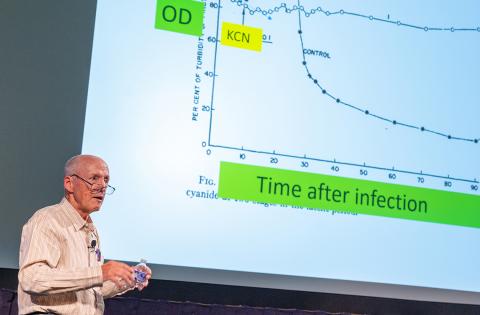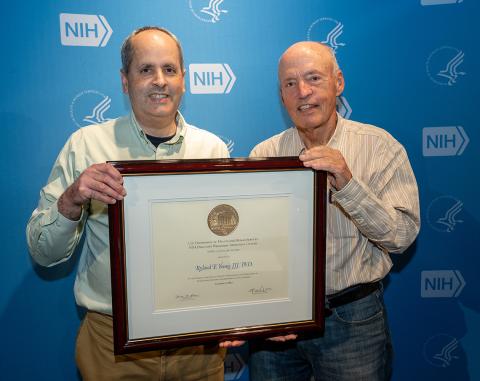Young Turns the Phage Toward New Therapies

Photo: courtesy of AgriLife
Germs can be exceedingly stubborn. As bacteria and fungi devise new ways to evade antibiotics, there’s an urgent need for alternative approaches to overcome these resistant germs. Researchers are moving ever closer to a viable alternative.
Phage therapy is emerging as an important tool against multi-drug-resistant bacterial infections. Much of what’s known about bacteriophages—viruses that target and kill bacteria—comes from research led by Dr. Ryland Young, featured speaker at NIH’s annual DeWitt Stetten Jr. Lecture.
“Even when others turned away from the field, [Young] saw the potential to use phages with their facile genetics, molecular biology and biochemistry to ask specific and important biological questions,” said Dr. Jon Lorsch, director of the National Institute of General Medical Sciences, who introduced the lecture.
Young, founding director of the Center for Phage Technology at Texas A&M University, has called phages “bacteria with brains.” Bacteriophages have tails allowing them to carry and insert their DNA into the targeted bacteria in seconds. These DNA tail phages are diverse and abundant in nature—found in soil, in the ocean—and in the human body.
Understanding phage lysis—how phages destroy the bacterial cell and wall—is integral to developing new antibacterial therapies.

Lysis was once believed to be a passive process. But back in medical school in 1977, Young discovered phage lysis might be a timed event.
While conducting phage infection experiments, he realized he had forgotten to infect one culture, so he started that infection three minutes later. Amazingly, all the cultures underwent lysis (the destruction of the bacterial cells) at the same time, except for the one late culture, which lysed exactly three minutes later. Further experiments would confirm phage lysis is highly controlled over time.
“This is a biological event that can keep time on the order of minutes to seconds,” Young said. “I have children who couldn’t keep track of time at the level of days.”
Young’s continuing research then revealed what’s regulating lysis timing, a single protein of 105 amino acids. He named that protein a “holin.”
Produced by bacteriophages, holins activate and control degradation of the host’s cell wall. There are more than 200,000 different holins among thousands of unrelated gene families, noted Young. A holin has two functions—to cause lysis and to cause it at the right time.

Photo: Leslie Kossoff
Lysis genes are often found on cassettes. Young focused on the lambda lysis cassette, which contains genes from one transcript that turns on eight minutes after infection.
“This makes it easy to study in terms of the kinetics,” he explained.
The lambda lysis cassette has four genes arranged in the order of the assaulted bacterial envelope. Each of these genes work to break through the cell’s wall and target the outer and inner membranes.
Holins, he said, accumulate in the cell membrane, where they reach critical concentration. The proteins aggregate and get converted into giant holes, which have the rather unfortunate name S-holes. These S-holes allow lysozymes to escape and attack the cell wall. By forming holes in the inner membrane, holins are causing instant cell death.
“After we started this crusade to understand the lambda holin, which I view as the most important protein and organism in the world, [we discovered] there are two functional types of holins,” said Young.
The new type of holin made tiny holes, or pinholes, about 100 times smaller than the canonical S-holes. These new “pinholins” are not as well timed as canonical holins, said Young. He showed a movie slide of pinholins lysing several genes, then eventually exploding. “If you did lambda S protein with this, they’d all be lysing in a minute or two, so it’s not quite as well controlled.”

Photo: Leslie Kossoff
Another critical type of protein in phage lysis is the spanin, which mediates the last step during lysis. In a nutshell, he said, there are two types of holins, two types of endolysins that target peptidoglycan (chains of peptides that form the bacteria’s cell wall) and two types of spanins.
“There are all these different possibilities and we’ve either found them in nature or constructed in a laboratory almost every combination of these three components,” said Young. “As far as we can tell, all double-stranded DNA phages use holin systems and I suspect there must be powerful evolutionary forces to make that happen.”
Bacteria are tricky, complex structures that aren’t easily overcome. Destroying them at the right time is key, and that’s where phage lysis comes in. After phages infect a bacterial cell and replicate, they can initiate lysis, which kills the bacteria while leaving the phages time to escape.
This process remains under study and holds vast potential as an alternative way to treat resistant bacterial infections.
